Zeal has taken the game a notch higher with the release of the Forecast goggle. We had the chance of giving the Forecast a test drive this summer in the Andes in Patagonia. Two lens choices were available, the Copper lens and the Polarized Phoenix lens. The Phoenix lens can be considered a “fire lens” due to the outer surface optical coating. The details of the coating technology or detail optical science will not be discussed in this review but rest assured it is best in class.
The polarized automatic lens whether it is in the Zeal Z3, Zeal Eclipse or the Zeal Slate has always been preferred because it is generally the only goggle lens you need for all conditions due to its photochromicity and its superior optical clarity and performance. The Zeal Forecast lenses we tested did not disappoint. The optical clarity of these lenses meets the Zeal standard and we believe it is best in class.
The copper lens is the good all around lens that was initially preferred in low-light conditions, especially when it is snowing or in heavy snow storms. The Polarized Phoenix lens goggle initially was for blue bird days. The high-end properties characteristic of Zeal goggles are definitely quite evident. Distortion of any kind was nonexistent, in both lenses and optical clarity maximized.
With time, the Polarized Phoenix lens became the preferred lens of choice; and not because it is cool looking and offers great eye protection from thermonuclear radiation in the ultraviolet range. For most coated lenses, optical dispersion is generally a problem from a chromatic aberration point of view but we found none. Any evidence of slight dispersion is when the sun is low in the sky, late afternoon or evening and if one is looking straight into the sun. The lens designers had this figured out as it never was really in your line of sight and minimal
On partly cloudy and partly sunny days, we find ourselves going for the Polarized Phoenix lens. The polarizer was superior to none and was particularly helpful in the land of BLUE ICE, Patagonia. The blue ice which is invisible to the naked eye clearly shows through the Polarized Phoenix lens even through a few inches of powder alerting you of where to avoid. The Polarized Phoenix lens did not interfere negatively with the LCD displays on portable devices like cell phones and cameras. However, rotating the device 90 degrees to go from landscape to portrait activates the polarization.
Under a variety of conditions, there was no evidence of fogging of the lens. Regardless of the weather conditions and whether touring (split boarding), mountain hiking, challenging alpine treks, powder riding or high speed carving, no fogging was experienced. The most demanding condition was a transition from snow to rain on a descent even then no fogging was experienced.


